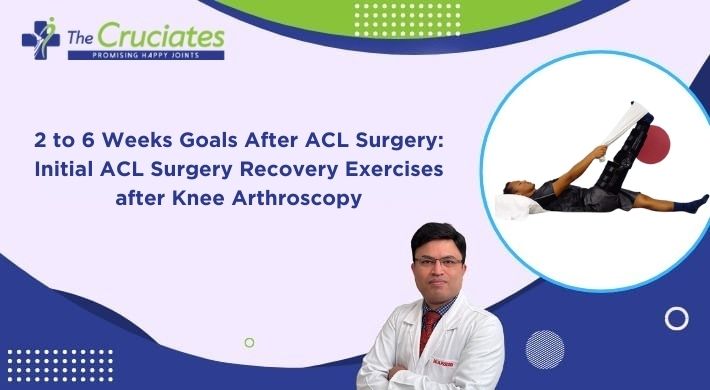Recovery after ACL (Anterior Cruciate Ligament) surgery is a journey that requires patience, dedication, and adherence to a well-structured rehabilitation program. The initial weeks following ACL surgery are crucial for laying the foundation of a successful recovery. In this blog post, we’ll explore the goals and ACL surgery recovery exercises recommended during the 2 to 6 weeks post-operative period to facilitate the healing process and regain knee function. Whether you’ve undergone ACL reconstruction surgery or repair, understanding these early-stage goals and exercises is essential for a smooth recovery journey.

Setting the Stage: ACL Surgery Recovery Overview
ACL surgery is a common orthopedic procedure performed to repair or reconstruct a torn anterior cruciate ligament, a key stabilizing structure in the knee joint. Following surgery, the rehabilitation process is divided into different phases, each focusing on specific goals and exercises tailored to the individual’s needs and progress.
2 to 6 Weeks Goals After ACL Surgery:
1. Reduce Pain and Swelling:
- Manage pain and swelling through the use of prescribed medications, ice therapy (cryotherapy), and elevation of the affected leg.
- Minimize discomfort and inflammation to improve mobility and facilitate early rehabilitation exercises.
2. Restore Range of Motion (ROM):
- Initiate gentle passive and active range of motion exercises to prevent stiffness and promote flexibility in the knee joint.
- Perform ankle pumps, heel slides, and pendulum exercises under the guidance of a physical therapist to gradually increase knee flexion and extension.
3. Improve Quadriceps Activation:
- Strengthen the quadriceps muscles, which play a crucial role in knee stability and function.
- Perform isometric quad sets and straight leg raises to activate and strengthen the quadriceps without placing excessive stress on the healing ACL graft or repair.
4. Enhance Hamstring Strength:
- Strengthen the hamstring muscles to provide dynamic stability to the knee joint and support the ACL.
- Incorporate exercises such as hamstring curls with resistance bands or on a leg curl machine to gradually build hamstring strength and endurance.
5. Establish Proprioception and Balance:
- Improve proprioception (the sense of joint position) and balance to enhance joint awareness and prevent re-injury.
- Practice weight-shifting exercises, single-leg stance, and balance board activities to challenge stability and coordination while protecting the healing knee.
6. Initiate Gait Training:
- Begin gait training exercises to normalize walking patterns and regain confidence in weight-bearing activities.
- Use assistive devices such as crutches or a walker initially, gradually transitioning to partial weight-bearing and eventually full weight-bearing as tolerated.
ACL Recovery Exercises at a Glance:
- Ankle Pumps: Perform dorsiflexion and plantarflexion movements of the foot to improve blood circulation and prevent blood clots.
- Heel Slides: Gently slide the heel along the surface towards the buttocks to promote knee flexion and extension.
- Quad Sets: Tighten the quadriceps muscles by pressing the back of the knee into the mat or bed while keeping the leg straight.
- Straight Leg Raises: Lift the leg straight up while lying on your back, engaging the quadriceps to strengthen the knee extensors.
- Hamstring Curls: Flex the knee against resistance to target the hamstring muscles and promote balanced muscle development.
- Balance Exercises: Challenge balance and stability using a balance board, foam pad, or wobble board while maintaining proper knee alignment.
- Gait Training: Practice walking with proper mechanics, focusing on heel-to-toe foot placement and a smooth, controlled gait pattern.
Conclusion:
The initial 2 to 6 weeks after ACL surgery set the stage for the rest of the rehabilitation journey. By diligently following the prescribed goals and exercises, individuals can lay a solid foundation for a successful recovery and eventual return to activities. However, it’s essential to work closely with a physical therapist or healthcare provider to ensure that the rehabilitation program is tailored to your specific needs and progress. Remember, patience, persistence, and proper guidance are key to achieving optimal outcomes in ACL surgery recovery.
By incorporating these initial ACL recovery exercises into your rehabilitation routine, you can take proactive steps towards regaining knee function, strength, and stability. Stay committed to your recovery journey, and don’t hesitate to seek support from our healthcare team whenever needed. With dedication and perseverance, you’ll be one step closer to achieving your goals and getting back to the activities you love.

